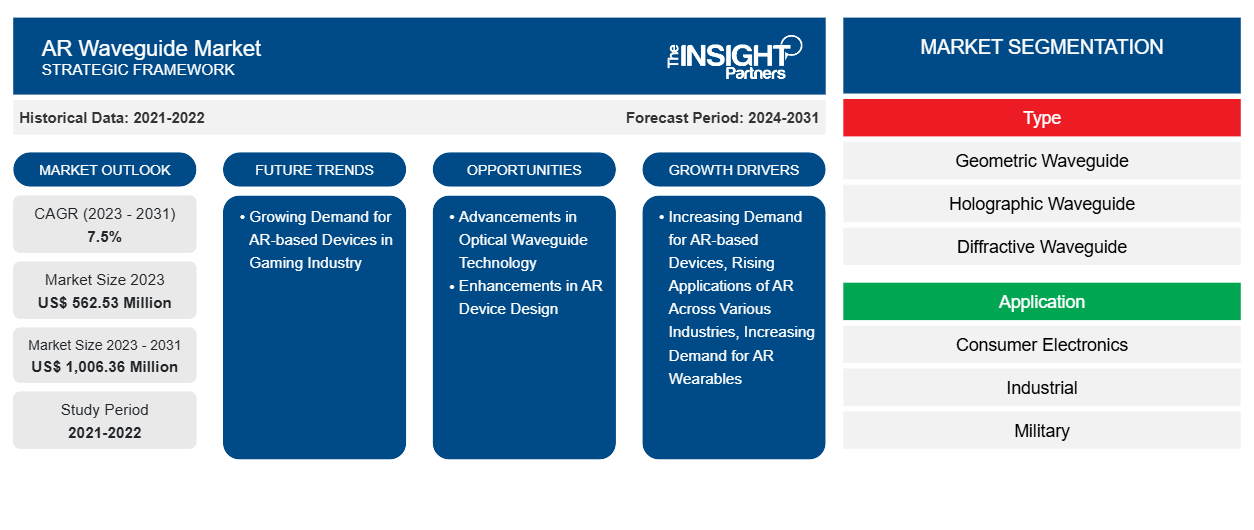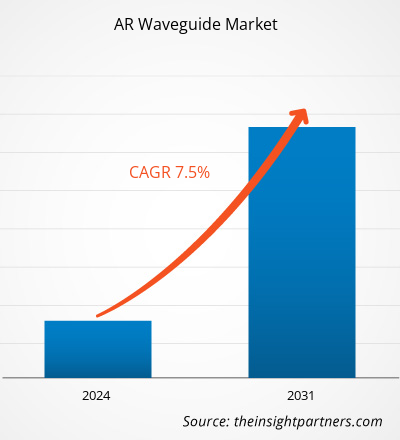The AR waveguide market size was valued at US$ 562.53 million in 2023 and is expected to reach US$ 1,006.36 million by 2031; it is estimated to record a CAGR of 7.5% from 2023 to 2031.
The report includes growth prospects in light of current AR waveguide market trends and driving factors influencing the market growth. A few of the market trends include technological advancement and growing demand for AR wearables.
AR Waveguide Market Analysis
The global AR waveguide market is experiencing significant growth in terms of revenues pertaining to increasing demand for augmented reality (AR) applications across various industries. AR waveguides provide a seamless and immersive AR experience, enhancing user engagement and interaction with digital content in the real world. In the gaming & entertainment industry, AR waveguides offer new and stimulating ways for users to engage with content. By overlaying digital elements in the real world, AR games provide highly effective visuals, graphics, and sound, creating an immersive experience for participants.
AR Waveguide Market Overview
The AR waveguide market refers to a cutting-edge technology that has the potential to revolutionize the experience of using augmented reality (AR) in various business sectors. It refers to a transparent optical element that guides and projects virtual images onto the real world, enhancing the user's visual perception and providing a seamless AR experience. AR waveguide has immense potential to transform numerous industries, including manufacturing, retail, healthcare, and education. One of the key advantages of this technology is its ability to overlay digital information onto the physical environment, offering users real-time data and contextual information that can significantly enhance their decision-making process. Furthermore, AR waveguide incorporates a transparent display system that enables the overlay of computer-generated visuals onto the physical environment. By leveraging the principle of total internal reflection, the waveguide efficiently guides light to create a virtual image that appears right in front of the viewer's eyes.
AR Waveguide Market Drivers and Opportunities
Increasing Demand for AR Wearables to Favor Market Growth
The demand for AR wearables such as smart glasses and headsets is growing worldwide. AR wearables equipped with waveguide technology offer users a hands-free and immersive AR experience, making them a widely used product in various industries, including consumer electronics, industrial, and military. AR-based solutions provide an immersive experience, which is a key feature supporting the adoption of such solutions among technology and e-commerce enterprises.
AR glasses, in particular, play a pivotal role in enabling well-informed purchasing decisions, contributing to the sales of eyeglasses and sunglasses. For instance, Lenskart Solutions Pvt Ltd. has integrated augmented reality (AR) technology into its smartphone application, allowing users to virtually try on eyeglasses, sunglasses, and other products before making a purchase. Similarly, LG Corporation incorporates AR functionality on its electronics website, enabling customers to visualize the way a specific TV set can be placed at their homes using mobile devices, aiding customers in their decision-making process. Thus, the increasing demand for AR wearables drives the AR waveguide market.
Customize This Report To Suit Your Requirement
You will get customization on any report - free of charge - including parts of this report, or country-level analysis, Excel Data pack, as well as avail great offers and discounts for start-ups & universities
AR Waveguide Market: Strategic Insights

-
Get Top Key Market Trends of this report.This FREE sample will include data analysis, ranging from market trends to estimates and forecasts.
Advancements in Optical Waveguide Technology
A few advancements in optical waveguide technology include diffractive waveguides and holographic waveguides. These technologies play a critical role in the deployment of AR devices across various sectors, including automotive, healthcare, aerospace & defense, education, and retail. Diffractive waveguides are considered the most utilized AR combiner technology and are used in popular devices such as Microsoft HoloLens, Magic Leap One, and Vuzix M4000. These waveguides use a diffractive optical element (DOE) to inject light into the waveguide, distribute it to a large exit pupil, and extract it to the eye. They offer ergonomic design and high-quality projected images, contributing to the immersive AR experience. For instance, in June 2023, Apple announced the Vision Pro, an augmented reality (AR) headset, at its annual Worldwide Developers Conference (WWDC). The headset features a high-resolution display with more than 23 million pixels, surpassing the quality of a 4K TV. It is powered by Apple's M2 chip, which is also found in their MacBook laptops, and a new chip called R1, specifically designed for the headset. The R1 chip processes the vast amount of data involved, including input from 12 cameras and sensors that face the user's eyes. This design aims to reduce lag and minimize motion sickness. The Vision Pro can be used all day when plugged in, but the battery life is limited to two hours when used wirelessly.
AR Waveguide Market Report Segmentation Analysis
Key segments that contributed to the derivation of the AR waveguide market analysis are type, application, and geography.
- Based on type, the market is segmented into geometric waveguide, holographic waveguide, and diffractive waveguide. The geometric waveguide segment held the largest market share in 2023.
- A geometric waveguide is an optical component that directs light from a display source, such as a microdisplay, to the viewer's eyes while also allowing them to see the outside environment. It is a critical component of AR glasses, enabling them to overlay digital information onto the user's field of view without impeding their vision of the physical environment. The geometric optical waveguide is designed and manufactured using traditional geometrical optics concepts and processes without the involvement of micro or nanoscale structures. As a result, the image quality, including color and contrast, can be improved dramatically. Geometric waveguides play an important role in the development of tiny and lightweight AR eyewear due to their huge application.
- Based on end user, the board management software market is segmented into consumer electronics, industrial, military, and others. The consumer electronics segment held the largest market share in 2023.
AR Waveguide Market Share Analysis by Geography
The geographic scope of the AR waveguide market report is mainly segmented into five regions: North America, Asia Pacific, Europe, Middle East & Africa, and South & Central America.
- The Europe AR waveguide market is segmented into Germany, France, Italy, the UK, Russia, and the Rest of Europe. Europe is known for its robust technology and high-quality manufacturing that has significantly bolstered the use of AR devices. Various councils across Europe have granted contracts to mass-manufacture high-quality AR waveguides. For example, in June 2023, Morphotonics received a European Innovation Council (EIC) Accelerator Grant. The EIC Accelerator supports small and medium enterprises to develop and scale up innovations. Moreover, various prominent AR waveguide manufacturers are present in Europe; these players include Waveoptics, Lumus, LetinAR, Holoptics, Optinvent, and Goertek.
- In Europe, various conferences were held where chief product officers explained the benefits of AR and its adoption. The conference AWE EU 2022 featured presentations on waveguide technology, which focused on highlighting industry interest in Europe. The Chief product officer of Dispelix briefed about the Dispelix DPX Selva product line and the way diffractive waveguide technology is integrated to launch solutions leveraging AR single-layer and full-color lightweight waveguide, along with discussed LED and LBS AR waveguide solutions and their benefits. Thus, such initiatives in the region propel the growth of the AR waveguide market.
AR Waveguide Market Regional Insights
The regional trends and factors influencing the AR Waveguide Market throughout the forecast period have been thoroughly explained by the analysts at The Insight Partners. This section also discusses AR Waveguide Market segments and geography across North America, Europe, Asia Pacific, Middle East and Africa, and South and Central America.
AR Waveguide Market Report Scope
| Report Attribute | Details |
|---|---|
| Market size in 2023 | US$ 562.53 Million |
| Market Size by 2031 | US$ 1,006.36 Million |
| Global CAGR (2023 - 2031) | 7.5% |
| Historical Data | 2021-2022 |
| Forecast period | 2024-2031 |
| Segments Covered |
By Type
|
| Regions and Countries Covered |
North America
|
| Market leaders and key company profiles |
|
AR Waveguide Market Players Density: Understanding Its Impact on Business Dynamics
The AR Waveguide Market is growing rapidly, driven by increasing end-user demand due to factors such as evolving consumer preferences, technological advancements, and greater awareness of the product's benefits. As demand rises, businesses are expanding their offerings, innovating to meet consumer needs, and capitalizing on emerging trends, which further fuels market growth.

- Get the AR Waveguide Market top key players overview
AR Waveguide Market News and Recent Developments
The AR waveguide market is evaluated by gathering qualitative and quantitative data post primary and secondary research, which includes important corporate publications, association data, and databases. The following is a list of developments in the AR waveguide market:
- In 2022, Lochn Optics made a breakthrough in holographic waveguide automation exposure and full-color display technology. (Source: Azeus Convene, Press Release, 2022)
- In 2022, Lochn Optics released an LBS diffractive waveguide AR module. Lochn Optics has developed a custom-designed diffractive waveguide and process suitable for this technology with full support from STMicroelectronics since mid-2021. (Source: Azeus Convene, Press Release, 2022)
- In 2024, LetinAR Inc. launched its "PinTILT" lens, which brings AR optics to the next level and successful commercialization cases with its global customers, including Jorjin, Nimo, and others. This technology was designed primarily to address common flaws present in current products, such as heavy and expensive hardware and insufficient features that impede the creation of true eyeglass-shaped designs and render wearability and usability subpar at best. (Source: Azeus Convene, Press Release, 2024)
- In 2024, NIL Technology (NILT), a leader in advanced optical solutions, announced metaEye, an ultracompact metalens-based camera with applications for eye-tracking, smart locks, biometrics, SLAM, and ubiquitous sensing across a range of applications, including gaming, presence detection, and smart appliances. This revolutionary metalens camera uses a patent-pending lens architecture only possible with metalenses to deliver an ultra-compact form factor, good performance, and environmental robustness. (Source: Azeus Convene, Press Release, 2024)
AR Waveguide Market Report Coverage and Deliverables
The “AR Waveguide Market Size and Forecast (2021–2031)” report provides a detailed analysis of the market covering below areas:
- Market size and forecast at global, regional, and country levels for all the key market segments covered under the scope
- Market dynamics such as drivers, restraints, and key opportunities
- Key future trends
- Detailed PEST and SWOT analysis
- Global and regional market analysis covering key market trends, major players, regulations, and recent market developments
- Industry landscape and competition analysis covering market concentration, heat map analysis, prominent players, and recent developments
- Detailed company profiles
Frequently Asked Questions
What are the driving factors impacting the AR waveguide market?
What is the estimated market size for the AR waveguide market in 2023?
What is the future trend of the AR waveguide market?
Which are the key players holding the major market share of the AR waveguide market?
What will be the market size for the AR waveguide market by 2031?
- Historical Analysis (2 Years), Base Year, Forecast (7 Years) with CAGR
- PEST and SWOT Analysis
- Market Size Value / Volume - Global, Regional, Country
- Industry and Competitive Landscape
- Excel Dataset
Recent Reports
Testimonials
Reason to Buy
- Informed Decision-Making
- Understanding Market Dynamics
- Competitive Analysis
- Identifying Emerging Markets
- Customer Insights
- Market Forecasts
- Risk Mitigation
- Boosting Operational Efficiency
- Strategic Planning
- Investment Justification
- Tracking Industry Innovations
- Aligning with Regulatory Trends





















 Get Free Sample For
Get Free Sample For